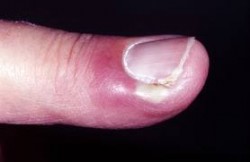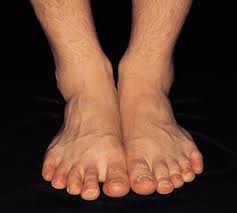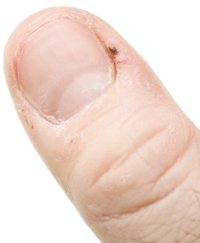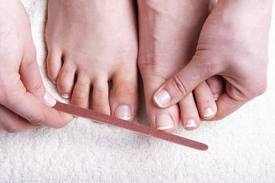Archive for the ‘Nail Fungus Prevention’ Category
Paronychia
Paronychia
 aronychia is a disease of the Perineum, where the skin around the surface of the nail hangs loosely. It has been found most often in the U.S., usually in kids who have a habit of biting their nails or sucking their fingers. There two forms of Paronchial infection, Chronic Paronychia and Acute Paronychia. The forms are judged according to the length of time it remains in the body.
aronychia is a disease of the Perineum, where the skin around the surface of the nail hangs loosely. It has been found most often in the U.S., usually in kids who have a habit of biting their nails or sucking their fingers. There two forms of Paronchial infection, Chronic Paronychia and Acute Paronychia. The forms are judged according to the length of time it remains in the body.
Paronychia is a viral infection that grows gradually stronger, resulting in a bumpiness, softness and redness surrounding the nails. The main culprits for this infection are Candida and mold. It can be passed from person to person via touch.
Causes of Paronychia
Most forms of Paronychia occur by a nick or break in the skin being infected. If a person has a hangnail or a habit of chewing their nails, this is a good way for the infection to enter the area. There is evidence of Streptococcus and Pseudomonas germs getting into the infected area and making it worse. The chronic form of Paronychia is typically linked with the use of abrasives, for instance soaps and detergents while washing. The chronic infections are typically the result of Candida albcans or other fungus.
Acute Paronychia occurs when the skin around the nail becomes inflamed and swells causing pain to the afflicted person. Pus may develop and ooze from the infected area, removing the top layer of the nail.
Chronic Paronychia is a longer lasting case and the nails can become so infected that they develop a greenish tinge around the edges of the skin.
Diagnosis
In the cases of Acute Paronychia, a culture of the pus can be taken to determine what kind (or kinds) of infection is occurring and then treatment can be prescribed. Chronic Paronychia can be a bit more difficult to diagnose and treat, though a potassium hydroxide test may be able to determine which fungus is the source of the infection.
Treatment
- Massaging the afflicted area in hot water three to four times per day can help relieve some of the pain and swelling
- Antibiotics such as diclogacilin and cephelaxin may be prescribed
- If the swelling is severe, the area may need to be punctured and drained
- Part of the nail may need to be removed in some cases
- An antifungal may also be prescribed
Things that should NOT be used to cure Paronychia
- Do not use topical antibiotics
- Do not take prescribed steroids
Unusual cases of people who have contracted Paronychia have occurred in patients with:
- HIV/AIDS
- On steroids
- High blood sugar
- Poor circulation
Prevention
- Don’t chew or bite your nails
- Don’t suck on your fingers or thumbs
- Don’t immerse your hands in water without wearing protective gloves
Nail Fungus Prevention Tips
Nail Fungus Prevention Tips
 “An ounce of prevention is worth a pound of cure.” So goes the old proverb and this is very true in the case of nail fungus prevention. Avoiding infection of your nails is a fairly simple process, but it does require diligence on your part. When you consider that once an infection has established itself, it is much more difficult to cure, working on prevention is in everyone’s best interest.
“An ounce of prevention is worth a pound of cure.” So goes the old proverb and this is very true in the case of nail fungus prevention. Avoiding infection of your nails is a fairly simple process, but it does require diligence on your part. When you consider that once an infection has established itself, it is much more difficult to cure, working on prevention is in everyone’s best interest.
The main problem is that nail fungus is not choosy about who it attacks. If it can find a successful living environment, it will.
People who are most subject to nail fungus infections are:
- People who sweat excessively in their hands and/or feet
- People who already have some sort of nail disorder
- People who have a weakened immune system
The risk of getting or not getting this disease seems to be fairly random. It will live wherever it can so “your best offense is a good defense”.
Prevention ideas
- Wear some sort of protective footwear when you are in public places where there is a lot of water, locker rooms, public baths and swimming pools are good examples. As you have no idea who may accidentally pass the spores along, protecting your own feet is paramount.
- Keep your nails short, clean, and dry. Trim and file your nails regularly to ensure that they are clean all over. Washing your hands and feet with soap and drying thoroughly afterward is also important as fungi like damp, dark places.
- Use antifungal sprays or powders to fight off the spores you may have already accidentally collected. Air out and dry out your shoes after wearing (especially if your feet sweat) and change your socks daily or wear sandals as often as possible.
- Don’t use nail polish as this locks in humidity and usually blocks light that might reach the fungus and help kill it off.
- If you choose to get manicures or pedicures, check with your salon to make sure they sterilize all of their equipment.
- Wash and dry your hands thoroughly before applying anything to your hands or feet and after applying ointment or medication anywhere else.
- Do not pick at the skin around your nails as this can cause irritation and allow the fungus to invade your skin.
- Pay attention to developing symptoms and if they show up, treat them early on to nip the infection in the bud
- Eat a healthy and balanced diet so that your immune system is up to fighting off any infection that comes your way.
Your health is in your own hands so grab it and go with it to keep your nails looking healthy and happy.
About the Condition Called Hangnails
About the Condition Called Hangnails
 Everyone wants to have healthy, attractive nails. However many people have hangnails. It is probably the most common nail ailment that humans face. There are various things we can do to prevent hangnails from developing and destroying the aesthetic beauty of the hand. Hangnails are not only unattractive, they tend to catch on hair, clothing, and other surrounding objects and can cause sudden and severe pain if they are bent backward to far. Many people look for ways to stop development of this irritating little problem. There are some simple solutions to avoiding hangnails.
Everyone wants to have healthy, attractive nails. However many people have hangnails. It is probably the most common nail ailment that humans face. There are various things we can do to prevent hangnails from developing and destroying the aesthetic beauty of the hand. Hangnails are not only unattractive, they tend to catch on hair, clothing, and other surrounding objects and can cause sudden and severe pain if they are bent backward to far. Many people look for ways to stop development of this irritating little problem. There are some simple solutions to avoiding hangnails.
What is a Hangnail?
Excess skin builds up around the base and side of the nail, the partially detaches from the nail itself, causing it to stick up and bend back. This can be very painful, as can trying to remove the hangnail, whether by cutting, biting or ripping it off.
What Causes Hangnails?
Hangnails are usually caused by dry cuticles. The cuticle is the skin that surrounds the nail, most commonly seen at the base of the nail. When the cuticle dries out it breaks and the skin detaches from the nail, creating a hangnail. If a person with a hangnail picks at it, bites at it or rips it off, it makes it more likely that this condition will continue as it just exacerbates the problem. People who spend a lot of time with their hands in water tend to suffer from hangnails as the skin gets soft and is then easily damaged. People who bite their nails are also more prone to hangnail. Children who bite their nails are usually afflicted with this nuisance.
How Do I Prevent Hangnails?
The easiest way to prevent hangnails from developing is to moisturize the cuticles. This is definitely a situation where preventing the problem is far better than dealing with it once it has occurred.
Some simple hangnail prevention tips:
- Don’t bite or rip off your hangnails. This frequently causes bleeding and may lead to infection. Use a small nail scissor to cut it close to the base which will inhibit further deterioration.
- Soak your hand in warm water for 5-10 minutes, dry thoroughly, then apply a moisturizing cream or oil to the skin surrounding the nails.
- Learn to stop biting your nails. If it’s really hard to stop, then investigate products that you can apply to your nails that will make them taste bad to help you resist the urge.
- Wear protective gloves when using harsh cleaning products or when you will have your hands immersed in liquid for a long period of time.
Living With A Nail Fungus Infection
Living With A Nail Fungus Infection
Having a nail fungus infection does not single you out, in fact it makes you part of the 20% of the world population that is also afflicted with this disease. Although it is unsightly, it is possible to live with, and cure, if you’re willing to put in the effort it may take. If you’re reading this, you may already be affected with this rather common disease. Below is more information to help you.
Nail fungus is a microorganism that lodges and grows on and under the nail. It can occur on both the finger and toenails. In fact, it’s really not a very discriminating fungus as it will happily grow anywhere it can. The biggest problem with nail fungus is not that it can do much harm, but that it takes so long for an infected person to notice the discoloration in their nail, and usually even longer for them to do anything about it. By then, the fungus has worked its way underneath the nail sheath and into the nail bed where it is much harder to get at. The fungus’s goal is to find a warm, wet place to survive. The infected person’s goal is to get rid of the fungus and get their healthy nail back! The faster you notice and start treating a fungal nail infection, the more likely you are to cure yourself of it.
 Avoid Becoming Infected in the First Place
Avoid Becoming Infected in the First Place
The simplest solution to a nail fungus infection is not to get it to begin with. There are lots of easy precautions you can take to avoid this disease.
- Think carefully about your regular day and where you might come into contact with these fungi. They tend to live in wet environments, like public bathrooms, locker rooms, public pools, etc. When you use these areas, make certain to wash your hands with an antibacterial soap. If you need to walk in these areas with exposed feet (for instance, to take a shower or get to the pool) wear a protective covering, like flip flops, to avoid contact with the fungus.
- Don’t wear wet clothes for a long period of time. If you get soaked in the rain, try to dry off and change as soon as possible. If you’ve been swimming, change out of your suit and into dry clothes before leaving the pool. If you sweat a great deal while working out, shower, dry thoroughly and change into clean clothes before leaving the gym. This rule is especially true to avoid toenail fungus infection as many people don’t change their socks and shoes after exercise and that is an ideal breeding ground for nail fungus.
- Stay healthy. Eat foods that will help you fight fungal infection, like yogurt and garlic. Take supplements of beta carotene, and vitamins B, C, D, and E. Use neem tree oil, tea tree oil, red thyme oil, and lemon oil on your skin to control a fungal infection if you contract one. Don’t eat yeast filled products, like brewer’s yeast or beer, if you have a nail fungus infection.
What Nails Are and How They Become Infected
What Nails Are and How They Become Infected
 Our nails look like clear, hard sheathes that cover part of our finger and eventually grow out over the edge. Most people have a bit of a pinkish tinge underneath their nails. The nail itself isn’t pink but allows the color of the skin and blood vessels directly underneath to show through. This is what a normal, healthy nail should look like.
Our nails look like clear, hard sheathes that cover part of our finger and eventually grow out over the edge. Most people have a bit of a pinkish tinge underneath their nails. The nail itself isn’t pink but allows the color of the skin and blood vessels directly underneath to show through. This is what a normal, healthy nail should look like.
A nail infection discolors the nail to a whitish or yellowish color at first, then as it grows, brown and black can become part of the color scheme.
Nails are made up of keratin, the same protein that builds our hair and the outmost layer of our skin. Keratin is a strong-celled protein that is fairly diverse. For our nails, it builds this lovely sheath to protect the soft part of the nail from harm.
How Does Infection Get Into the Nail?
Really what happens is that a fungal infection gets under the nail. Just like their cousins, the mushroom, the fungal spores that grow and invade the nail bed want to be in a warm, dark, damp place to grow. We come into contact with these spores on a regular basis. Some of them are harmless and wash off with no effect to us. Others try to seek a parasitic relationship with our bodies, using us as a means to grow and spread themselves.
Most people don’t realize when or where they might come into contact with these parasitic fungal spores. The answer is, pretty much everywhere. Germs, viruses, and spores are part of the make-up of our eco-system. Having a healthy immune system is what allows our bodies to fight these things off.
The fungus that most commonly causes nail infection is called a dermatophyte. We come into contact with them every day and for most people, no harm is caused. However, for people with certain diseases, like diabetes, or who have poor circulation, or even who have been sick for a long time, so their immune system has been working overtime, these parasitic fungi find a happy breeding ground. The most commonly affected area is the toenail, as it is usually kept in the dark and surrounded by warm fabric that has the potential to hold in moisture. Fingernail fungus infections occur most often in people who spend a great deal of time with their hands in the water or exposed to harsh chemicals.
Fungus grow very slowly, so by the time the infected person notices the discoloration of their nail, the fungus has already established a fairly good hold on the nail. Usually it gets underneath the nail at the tip of the toe by working its way underneath and into the protected nail bed. It can also get into the soft tissue surrounding the nail and work its way under from there. Nail Fungus Infections aren’t incredibly dangerous, but they do take a very long time to treat, as the fungus isn’t gone until the nail has grown out entirely clear.
What can I do to prevent it?
There are lots of ways you can prevent nail fungus from getting to your nails in the first place. This is your best bet.
- Keep your nails trimmed close to the edge of the finger or toe tip. The less space there is at the edge of the nail for the fungus to get on, the less likely it will be to grow.
- Wash your hands and feet regularly and dry them thoroughly. Wear clean socks every day and make sure your shoes dry out entirely before wearing them, especially if you wear the same shoes every day.
- Wear something on your feet when in public areas that have a lot of water, like swimming pools or locker rooms. And make sure those shoes have a chance to dry out too!
If I Get Infected, How Do I Treat It?
There are a great many home remedies suggested on this and other websites. Over-the-counter remedies and medications are another good idea. If you’re going to try to treat it yourself, start working with one of these remedies and wash the affected area at least twice a day, then dry it thoroughly. Wear clean socks if it’s a toenail infection, even to the point of changing your socks a couple times a day. Right after washing your feet. And if it is possible for you to wear sandals, exposing your feet to the light also helps.
If your infection is severe or well advanced, a visit to your doctor to figure out what kind of fungal infection it is and what treatment options are available to you will be your next step.